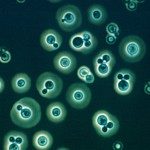Lien vers Pubmed [PMID] – 21533164
PLoS ONE 2011 Apr;6(4):e18551
BACKGROUND: Corynebacterium pseudotuberculosis, a gram-positive, facultative intracellular pathogen, is the etiologic agent of the disease known as caseous lymphadenitis (CL). CL mainly affects small ruminants, such as goats and sheep; it also causes infections in humans, though rarely. This species is distributed worldwide, but it has the most serious economic impact in Oceania, Africa and South America. Although C. pseudotuberculosis causes major health and productivity problems for livestock, little is known about the molecular basis of its pathogenicity.
METHODOLOGY AND FINDINGS: We characterized two C. pseudotuberculosis genomes (Cp1002, isolated from goats; and CpC231, isolated from sheep). Analysis of the predicted genomes showed high similarity in genomic architecture, gene content and genetic order. When C. pseudotuberculosis was compared with other Corynebacterium species, it became evident that this pathogenic species has lost numerous genes, resulting in one of the smallest genomes in the genus. Other differences that could be part of the adaptation to pathogenicity include a lower GC content, of about 52%, and a reduced gene repertoire. The C. pseudotuberculosis genome also includes seven putative pathogenicity islands, which contain several classical virulence factors, including genes for fimbrial subunits, adhesion factors, iron uptake and secreted toxins. Additionally, all of the virulence factors in the islands have characteristics that indicate horizontal transfer.
CONCLUSIONS: These particular genome characteristics of C. pseudotuberculosis, as well as its acquired virulence factors in pathogenicity islands, provide evidence of its lifestyle and of the pathogenicity pathways used by this pathogen in the infection process. All genomes cited in this study are available in the NCBI Genbank database (http://www.ncbi.nlm.nih.gov/genbank/) under accession numbers CP001809 and CP001829.
